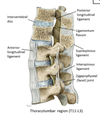MSCT Week 1: Back and Spinal Cord Flashcards
The vertebral column AKA
Spine
The Vertebral Column has how many vertebrae
33 Vertebrae
How many Cervical Vertebrae?
7
How many Thoracic Vertebrae?
12
How many Lumbar Vertebrae?
5
How many Sacral Vertebrae?
5
How many coccygeal Vertebrae?
3-5
Surface Landmarks of the back
3 Listed
- vertebrae prominens
- scapula
- iliac crests
Useful landmarks for a lumbar puncture?
A horizontal line between the Iliac Crests passes through the spinous process of L4 and the L4-L5 disc
Identify


Natural Curvatures of the Vertebral column
- Kyphotic curvatures
- Lordotic curvatures
Kyphotic Curvatures
- Thoracic
- Sacral
The primary curvatures
- Kyphotic Curvatures: thoracic and sacral regions
The secondary curvatures
- Lordotic curvatures: Lumbar and Cervical regions
which curvatures are postnatal?
secondary curvatures
Lordotic curvatures: cervical and lumbar
Which spinal curvatures are present from birth?
- Primary curvatures
- Thoracic and sacral Kyphotic curvatures
Kyphosis is?
excessive forward curvature (flexion) of the thoracic spine. It may be congenital or posture related but it is usually due to a collapse of the vertebral bodies
Lordosis is?
excessive inward curvature (extension) of the lumbar spine that can develop temporarily during pregnancy, pathology, or excess weight
Scoliosis is?
an abnormal lateral curvature of the thoracic or lumbar spine. it may be congenital, idiopathic or caused by diseases such as cerebral palsy and muscular dystrophy
Idiopathic definition
relating to or denoting any disease or condition that arises spontaneously or for which the cause is unknown.
Congenital definition
(especially of a disease or physical abnormality) present from birth.
Identify


Identify?


The secondary curvatures develop after _______ when …
- Birth
- infants learn to hold their head up and walk
spinal curvature that develops when infants learn to hold their head up?
Cervical Lordotic curvature
The spinal curvature that develops when infants learn to walk?
Lumbar lordotic curvature
The intrinsic muscles of the back do what?
Maintain posture and move the vertebral column
The extrinsic muscles of the back do what?
move the upper limbs and ribs
Movement patterns of the vertebral column?
- Extension
- Flexion
- Lateral Flexion
- Rotation
A vertebra consists of ____________, _______________, and ___________ for _________ attachment and ___________ with _________.
A vertebra consists of a vertebral body, a vertebral arch, and processes for muscle attachment and articulation with bones
The vertebral arch is formed by ________________ that attach to the ___________ and paired _____________ that join to form the spinous process.
The vertebral arch is formed by paired pedicles that attach to the vertebral body and paired laminae that join to form the spinous process.
Transverse processes project ______ from the __________.
Transverse processes project laterally from the vertebral arch
Superior and inferior processes articulate with vertebrae _________ and _________.
Superior and inferior processes articulate with vertebrae above and below.
Identify


Identify


Spinal nerves exit from?
Intervertebral foramina
Intervertebral joints and articular surfaces of vertebral bodies are?
Symphyses, Fibrocartilaginous joints that are only slightly mobile
Annulus Fibrosis
Fibrocartilage rings found in between vertebral body articular surfaces
Nucleus Pulposus
Gelatinous material surrounded by the annulus fibrosis
A Herniated Disc pathology?
Degeneration of the annulus fibrosis leads to herniation of the nucleus pulposus which can impinge on the spinal cord or spinal nerves
Zygapophyseal joints AKA
Facet Joints
Superior and inferior articular processes are?
Synovial joints called Zygapophyseal joints which contain fluid and allow for movement but are prone to arthritis

posterior herniation
+
Posterolateral herniation
Supraspinous and interspinous ligaments
attach the spines of adjacent vertebrae to each other
The interspinous and supraspinous ligaments continue superiorly as the?
Nuchal ligament
Nuchal ligament
extension of the interspinous and supraspinous ligaments and attaches to the external occipital protuberance of the skull;
Nuchal ligament main function
Limits flexion of the cervical spine
Flavum means …
Yellow





















